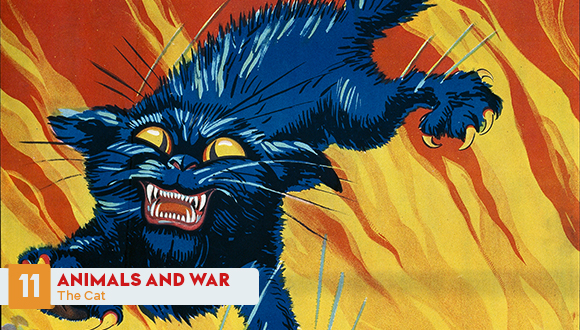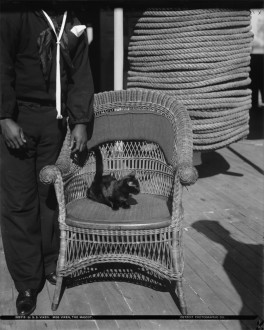
“Treat’em Rough! Join the Tanks”. A 1917 recruitment poster by American illustrator August “Gus” William Hutaf © Paris, musée de l’Armée, Dist. RMN-GP / image musée de l’Armée
On this poster no human being is visible. British Mark tanks fire in all directions as they ride over the trenches and the barbed wire in No Man’s Land. An attacking cat leaps above the battlefield as flames rage overhead. Flattened ears, prominent claws out and bristly hair are classic elements associated with angry felids. The double pair of canines, the Amber eyes with irises which seem to fix the viewer, the yellow claws whose red top look like flames, further reinforce the wild look of the animal. In many cultures, the black cat is perceived as a disturbing and evil animal. His presence interpreted as bad omen, he is often associated with witchcraft, even to the devil himself. Here, on the other hand, he symbolizes courage, independence and freedom. The United States Tanks Corps chose “Black Tom”, the famous black cat as its mascot.
The cat
“Living Torches”
As early as Antiquity, war machines were named after animals: horses, cat, rats, moles and hedgehogs. They were used to fire all kinds of projectiles against the enemy, including live animals and decaying animal corpses capable of transmitting diseases. Oxen, pigs, dogs, rats and cats were equally used as living incendiary devices. Incendiary material was attached to their bodies, and then the animals, terrified and undergoing excruciating pain, tried desperately to escape and seek refuge in a safe place. This practice was still in use during the First Indochina War (1946-1954), as Paul Bonnecarrère recorded in his book Pour le sang versé: “For a moment, we thought it was a home-made bomb, when, with amazement, we saw a cat landing on its feet. On its tail was tied a strand of tinder. Suddenly, the animal ignited itself like a torch and begun to scream, running in all directions. It was followed by five, ten, and finally a hundred crazy cats that all went up in a fiery blaze… “.
In contemporary conflicts, incendiary materials are sometimes replaced by a magnetic mine attached to the collar of the animal. During the Second World War, Sweden used seals against German submarines, and the Soviets sent dogs to destroy German tanks…
Launching the Assault on the Rodents
The embarkation of cats aboard exploration, trading and naval ships began shortly after the domestication of this animal, dating back to around 8000 years ago. His mission was to exterminate the rodents which caused damages to ropes and other materials making up the ship, devoured the foodstuff and contaminated it with excreta, spreading formidable diseases to the crew such as leptospirosis. The “ship’s cat” quickly became the favourite of the ship’s crew, a mascot pet who offered companionship and eased the tensions amongst the crew members. The ship’s cat was regarded as a member of the crew and had his name entered in the ship’s registry. The British Royal Navy banned all cats on her ships in 1975.
Many photographs of the First World War show cats in the trenches. The animals left the bombed villages in search of food they hoped to find in the trenches which ended up being invaded by rodents. The soldiers became attached to cats and other animals in search of caresses and food. As on ships, they quickly became the good-luck pet of the unit, although the Army was initially against it… They were also used on the front to detect toxic gases.
“Also We Serve”: Honoured in Memory
In 1943, the PDSA Dickin Medal was instituted in the United Kingdom to honour the work of animals that served in the war effort. Amongst the 54 animals awarded the Dickin Medal, there are many dogs and pigeons, but also one cat, Simon of HMS Amethyst. British sculptor David Backhouse depicted Simon on one of the bas-relief of the Animals in War Monument unveiled by HRH The Princess Royal in Park Lane, London, in 2004.
To Present Day
An article published in Le Monde in 2014, states: “Nowadays, terrorist organizations use mascots of Western societies in order to propagate a positive image on social networks. Why the cat? […] Partly, because this animal which has long been considered to be too independent, too unfaithful and a vagrant, has become, since the middle of the twentieth century, at a time when individualistic values started emerging, one of the star companions in Western societies.”




Ajouter un commentaire